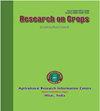广谱除草剂混合物对印度东海岸平原地区湿直播稻(Oryza sativa L.)杂草群的功效
Q3 Agricultural and Biological Sciences
引用次数: 0
摘要
湿直播稻(DSR)的杂草种类繁多,成为其成功种植的主要制约因素。广谱除草剂混合物可作为缓解这一问题的武器,消除杂草转移、除草剂抗性等挑战。因此,在 2020 年和 2021 年的 Kharif 季节,在位于印度东海岸平原地区,特别是奥迪沙中部台地农业气候区的 Cuttack ICAR 国家水稻研究所的研究所农场进行了一项实验,以评估不同除草剂混合物在成功管理杂草方面的效果。试验采用随机整群设计,包括 12 个处理,即 9 个芽后除草剂混合物(试验组合)、1 个芽后除草剂对照、1 个无杂草处理(T11)(通过人工除草保持无杂草地块)和 1 个杂草对照(T12),重复三次。小区净面积为 5.8 × 3.8 米(22.04 平方米)。试验品种 CR Dhan 203 的播种行距为 20 厘米。无杂草处理(T11)与精噁唑禾草灵 6.7% EC(重量比)+醚嘧磺隆 15% WDG(重量比)(50+15)克/公顷(T4)、五氟磺草胺 21.7% SC+ 氰氟草酯 12% EC (w/v) (25+100) g/ha (T3);唑嘧磺隆 50% DF+ 双唑草酮钠 10% SC (22+25) g/ha (T1)、氟嘧磺隆 10%WDG(重量比)+双唑草胺 10%SC(25+25)克/公顷(T2)、双唑草胺 10%SC+乙嘧磺隆 15%WDG(重量比)(25+15)克/公顷(T5)的谷物产量表现较高。同时,杂草动态和相对杂草密度也最低。在除草剂处理中,精恶唑禾草灵 6.7% EC(重量比)+醚嘧磺隆 15% WDG(重量比)(50+15)克/公顷(T4)的除草效率最高(86.49%),杂草指数最低(6.69%),因此是农作物生产中最可行、最可采用的组合。本文章由计算机程序翻译,如有差异,请以英文原文为准。
Efficacy of broad-spectrum herbicide mixtures on weed flora in wet direct seeded rice (Oryza sativa L.) in the east coast plain region of India
Wet direct seeded rice (DSR) attributing floristically diverse weed flora which emerges as main constraints for its successful cultivation. Broad spectrum herbicide mixtures can be acted as weapon for mitigating this issue by nullifying the challenges like weed shift, herbicide resistance etc. Consequently, an experiment was conducted at the Institute Research Farm of ICAR-National Rice Research Institute, Cuttack, situated in the east coast plain region of India specifically in mid-central table land agro-climatic zone of Odisha during the Kharif seasons of 2020 and 2021 to assess the effectiveness of different herbicide mixtures in managing weeds successfully. The experiment was laid out in Randomized Complete Block Design encompassing 12 treatments, viz., nine post-emergence herbicide mixtures (experimental combinations for testing), one post-emergence herbicide check, one weed-free (T11) (weed-free plots were maintained by hand weeding) and one weedy check (T12), replicated thrice. The net plot size was 5.8 × 3.8 m (22.04 m2). The test variety CR Dhan 203 was sown in 20 cm rows apart. Weed-free treatment (T11) was at par with fenoxaprop-p ethyl 6.7% EC (w/w) + ethoxysulfuron 15% WDG (w/w) (50+15) g/ha (T4) , penoxsulam 21.7% SC+ cyhalofop-butyl 12% EC (w/v) (25+100) g/ha (T3) , azimsulfuron 50% DF+ bispyribac sodium 10% SC (22+25) g/ha (T1), flucetosulfuron 10% WDG (w/w) + bispyribac sodium 10% SC (25+25) g/ha (T2) , bispyribac sodium 10% SC + ethoxysulfuron 15% WDG (w/w) (25+15) g/ha (T5) for high performance in terms of grain yield. Also showed lowest weed flora dynamics and relative weed density as well. Among the herbicide treatments, fenoxaprop-p ethyl 6.7% EC (w/w) + ethoxysulfuron 15% WDG (w/w) (50+15) g/ha (T4) registered the highest weed control efficiency (86.49%) and lowest weed index (6.69%), hence demonstrating as most viable and adoptable combinations for agricultural crop production.
求助全文
通过发布文献求助,成功后即可免费获取论文全文。
去求助
来源期刊

Research on Crops
Agricultural and Biological Sciences-Soil Science
CiteScore
1.50
自引率
0.00%
发文量
93
审稿时长
1 months
期刊介绍:
The Research on Crops is a peer-reviewed journal publishing original research papers, review articles and short communications in English on all basic and applied aspects of crop sciences, agricultural water management, agro-climatology, agroforestry, agronomy, crop production, crop protection, cropping systems, food science & technology, genetics & plant breeding, horticulture, plant & soil science, plant biotechnology, plant nutrition, post-harvest management of crops, seed science, soil management & tillage, vegetables, weed science, agricultural engineering, agri-business, agricultural economics and extension, etc. The aim of the journal is to provide a forum for the scientific community to publish their latest research findings.
The manuscripts submitted for publication should not contain data older than 4 years on the date of submission.
The articles submitted for publication in this journal should not be submitted elsewhere simultaneously for publication in another journal. These should not carry any copyright material without prior permission of copyright holder.
The articles should present a complete picture of the investigation made and should not be split into parts.
There is no prescribed limit regarding the number of pages in case of full-length articles. However, the authors are advised to keep the length of their articles from 4 to 10 full printed pages of the journal.
The articles should be divided into the sub-sections: ABSTRACT, INTRODUCTION, MATERIALS AND METHODS, RESULTS AND DISCUSSION, CONCLUSIONS, and REFERENCES. Tables and figures should be appended separately at the end.
 求助内容:
求助内容: 应助结果提醒方式:
应助结果提醒方式:


